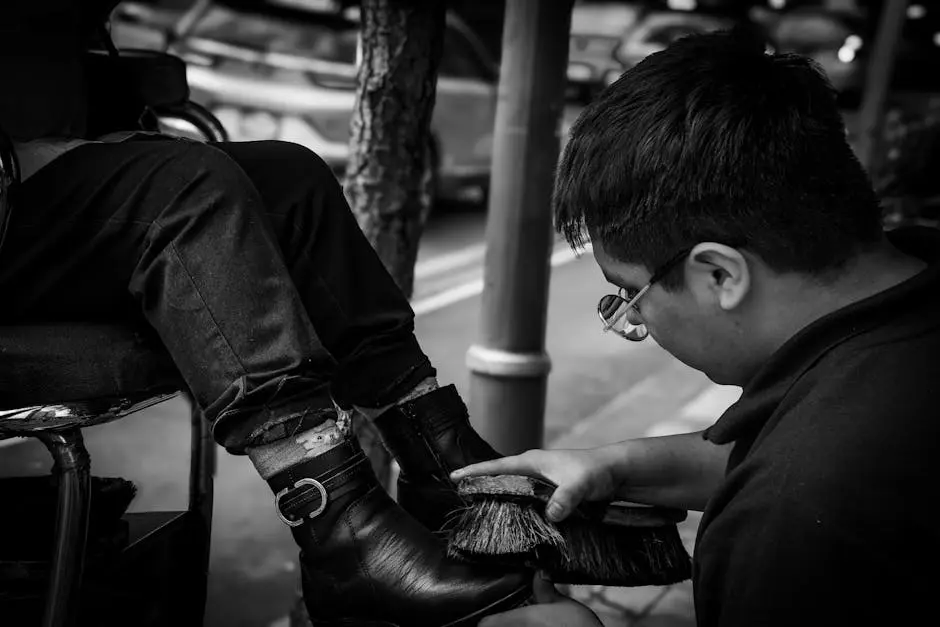7 Features to Look for in Quality Work Boots for Men
Share
Finding the right work boots is essential for comfort, safety, and durability, especially when you have a demanding job. This guide will walk you through the top features to consider to make sure you’re getting the best work boots for the job.
1. Comfort is Key
A good pair of work boots should prioritize comfort. Look for features like cushioned insoles and padded collars to keep your feet happy throughout the day. But why stop there? You might want to also consider boots that offer adjustable lacing systems to get that snug fit tailored specifically to your foot shape. With the right comfort measures, your feet will thank you, especially after long hours on the job. It’s not just about feeling good; it’s about preventing discomfort and potential injury. Having a comfortable base can make a significant difference in your overall work performance.
Think about materials like memory foam, which can offer a custom comfort experience by molding to the unique shape of your feet. Additionally, shock-absorbing midsoles can reduce the impact on your joints, making each step easier and more comfortable. Imagine walking on surfaces where every footfall is cushioned perfectly! These features aren’t just luxuries; they’re necessities for anyone spending substantial time on their feet. Making sure the lining is breathable also ties into comfort because it helps regulate the climate inside the boots, keeping you cool.
2. Safety First with Steel Toe Protection
Steel toe boots provide essential protection against heavy objects and potential hazards, making them a must-have in any work environment. But, did you know they’re not the only game in town? The choice between steel and alternatives like composite toe depends on your specific needs—steel offers robust protection, while composite can be lighter. Whatever your choice, reinforced toe areas can prevent crushing injuries which are more common in challenging work settings. Work safely and confidently knowing that the fronts of your feet are guarded well. Safety features also improve workplace morale!
It’s not just about the toe; other safety features are crucial too. Consider electrical hazard protection if you’re in an environment with potential exposure to live circuits. This feature can act as another layer shielding you from risks. Additionally, look for metatarsal guards if you need further protection over the top of the foot. The boots should meet specific safety standards that ensure they have been tested to handle workplace threats. Checking for ASTM or ANSI certification can give you that extra peace of mind.
3. Durability for Long-Lasting Wear
High-quality materials like leather and reinforced stitching ensure your boots will withstand the wear and tear of daily use. Think about how often you replace other work gear—a durable boot saves money in the long term. Investing in quality might seem steep initially, but it pays off when you don’t have to buy a new pair every few months. Details such as welt construction (like Goodyear welt) can affect how long the boots will last, especially if they are subjected to strenuous conditions. You want boots that are scrupulously stitched and not just glued, which provides optimal resilience.
Also consider that the type of leather—full-grain is excellent for toughness, while nubuck combines strength with some softness—plays a role in durability. Some boots also incorporate reinforced eyelets and double-stitched seams to add an extra layer of security against tears. Abrasion-resistant outsoles can stand up to concrete, gravel, and other harsh surfaces. Your work boots are your foundation, keeping you steady across rough terrains. It’s these small details in construction that collectively make a significant difference in the life of your boots.
4. Waterproof Features
Staying dry is crucial, so ensure your boots offer reliable waterproofing to protect against wet conditions. Wet feet can lead to discomfort, blisters, and even freezing in colder weather. Using materials with a waterproof membrane can be a game changer, as it keeps water at bay while also allowing moisture from inside to escape. This dual action is vital for maintaining dry feet all day long. Check for seam-sealed designs that don’t allow for any seepage at the stitching—every bit of waterproof technology helps.
Boots with gusseted tongues can prevent water from sneaking in around the lace area. It’s also worth seeking out boots designed with a moisture-wicking lining because even if water doesn’t seep in, sweat can create a damp environment. For those in particularly wet environments, investing in boots with complete waterproof construction (like rubber) may be beneficial. Keep in mind, however, that breathability should not be compromised in pursuit of waterproofing. Aim for a balance where your feet are shielded from external moisture while remaining ventilated inside.
5. Slip Resistance
Look for outsoles with strong grip and slip resistance to maintain stability and safety on any surface. Technology in tread patterns can make a significant difference, especially when working on slick or uneven surfaces. The construction of the sole can help channel away liquids that cause slips, ensuring your foot stays steady even in precarious conditions. You certainly don’t want to worry about slipping when you’re focused on your tasks.
Some outsoles are designed with composite rubber or advanced materials that enhance slip resistance without sacrificing flexibility. Knowing the type of environment you’ll be traversing is key; for example, boots with oil-resistant tread are ideal for kitchens or workshops where spills are common. Paying attention to the lug pattern and depth can offer insights into how the boot will perform across different terrains. A combination of deep grooves and a flat contact surface can provide a versatile solution for varied work settings.
6. Breathability for Optimal Foot Health
Breathable materials help to reduce moisture and prevent odor, keeping your feet fresh and comfortable. Imagine feeling as though you’re wearing comfortable sneakers rather than constricting boots! Fabrics like Gore-Tex or mesh can let air flow through the boots, an important feature when you’re active and likely to sweat. This airflow discourages fungal growth and the development of odors, promoting healthier feet. It’s also about extending the usability of the boot interior—dry is durable.
Another aspect of breathability lies in proper ventilation design. Features like mesh panels or vented sections are a must if you work in particularly hot environments. These features ensure constant airflow, essential for maintaining optimal foot health. While it’s important that the boots breathe, they should not lose integrity in wet or rugged conditions, achieving the right balance between ventilation and ruggedness is crucial. Selecting breathable boots will be a step in the right direction towards prolonged comfort.
7. Adequate Support and Arch Design
Proper arch support is key to preventing foot fatigue, especially for those on their feet for extended periods. Imagine the relief of standing firmly without strain—good arch support spreads your body weight evenly across your feet, reducing stress and preventing pain. Orthotic insoles are a worthwhile investment for those seeking superior arch support. When shopping for work boots for men, you should seek those that offer built-in arch support or have provision for custom orthotics.
Beyond arches, heel and ankle support also contribute to overall comfort. Consider boots with contoured footbeds or heel lock lacing systems that maintain structure through each step. Last but not least, the fit of the boot must not be too tight or too loose because either could lead to blisters or sprains. Additionally, understanding your foot type—whether flat, neutral, or high arch—can guide you in selecting the most supportive design. A well-supported foot not only feels good but also performs well over time.

